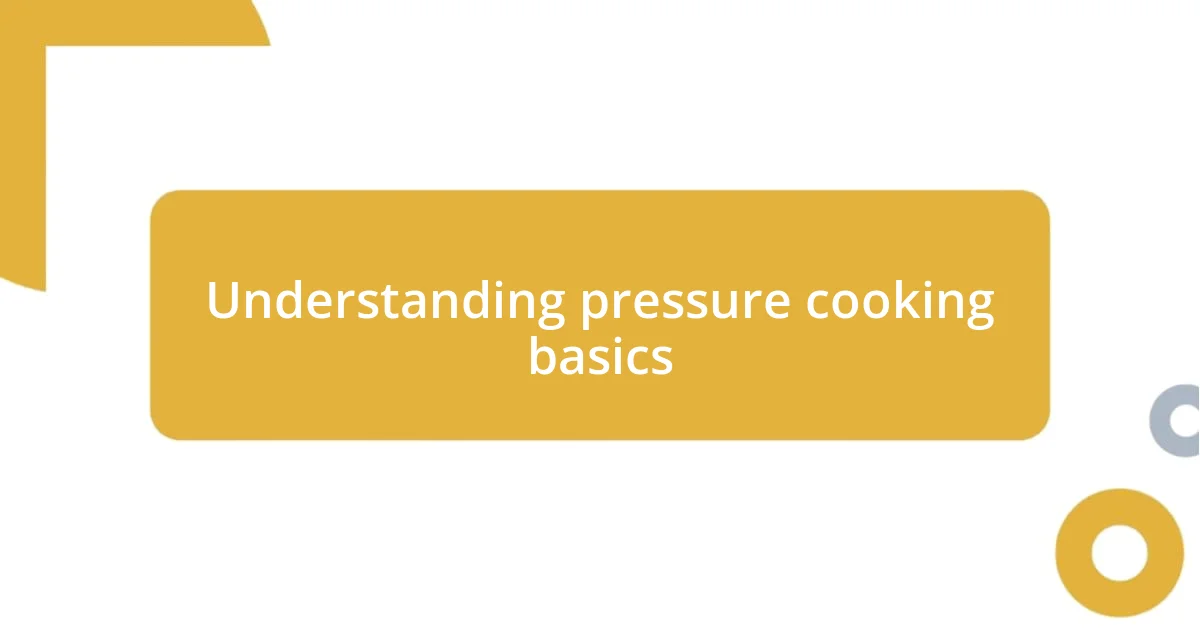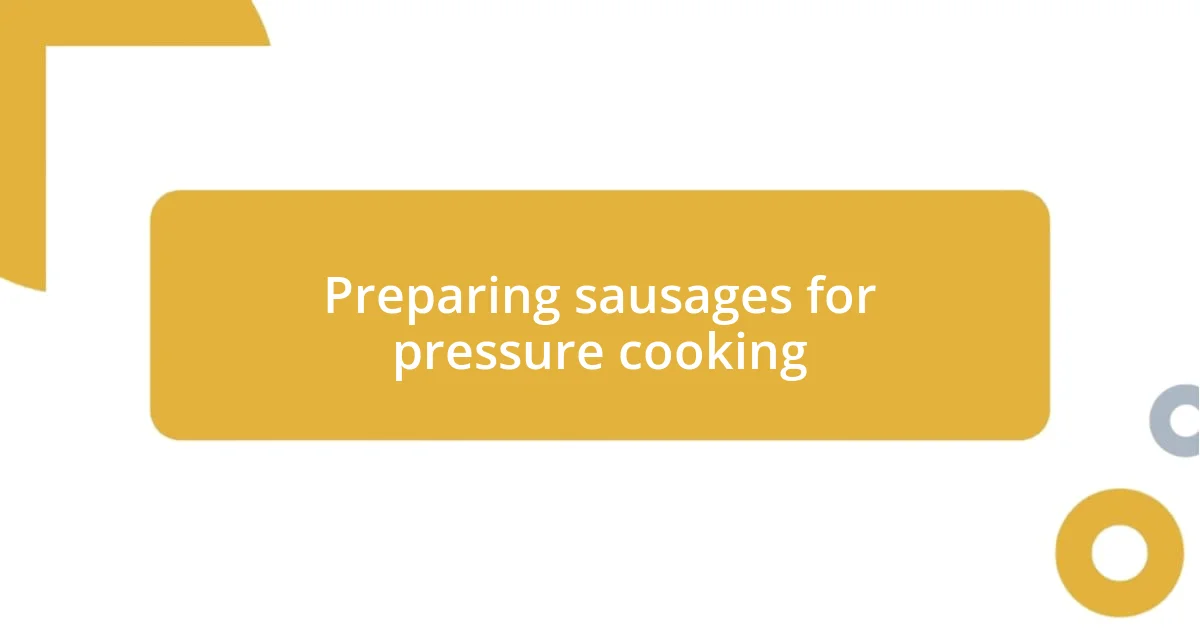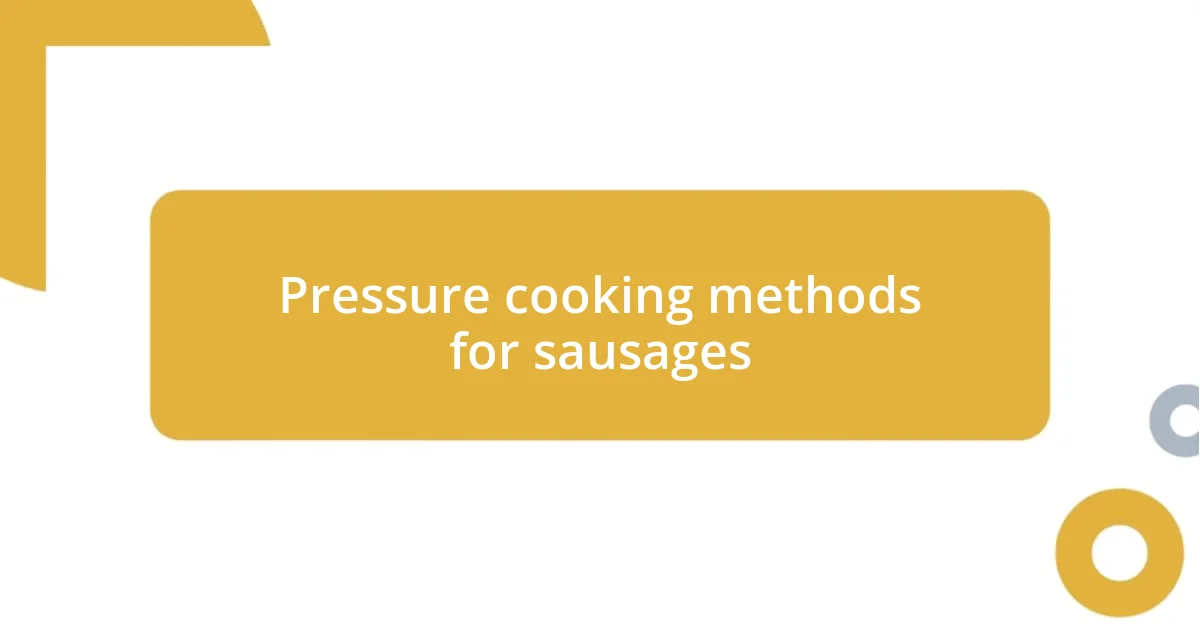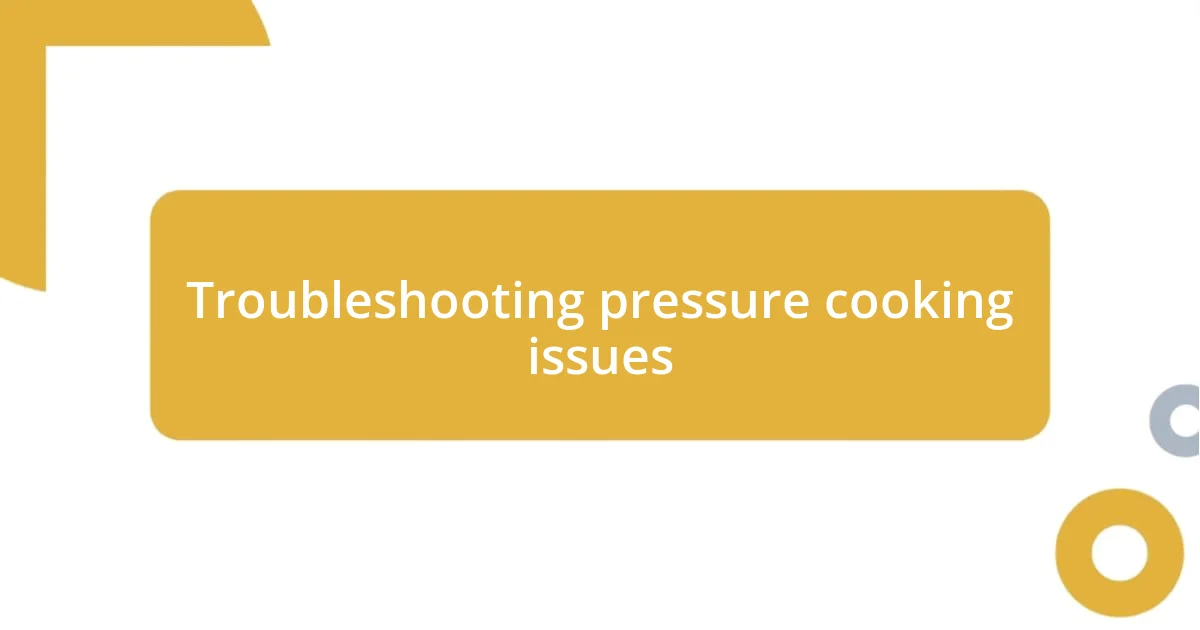Key takeaways:
- Pressure cooking enhances flavor and nutrient retention, making meals quicker and healthier.
- Careful selection of sausages, considering quality, fat content, and flavor, greatly influences the final dish.
- Timing, temperature, and proper pressure release techniques are crucial for achieving perfectly cooked sausages.

Understanding pressure cooking basics
Pressure cooking is all about cooking food quickly and efficiently by trapping steam to create high pressure inside the pot. I remember the first time I used my pressure cooker; I was mesmerized watching the steam escape and imagining how all those flavors would meld together in such a short time. Isn’t it fascinating how this method not only speeds up the cooking process but also helps retain nutrients?
One of the key elements of pressure cooking is the sealing mechanism. When I realized that a tiny gasket and a secure lid could transform my lunch preparations, it was like unlocking a new level in cooking for me. Have you ever thought about how much time we could save if we embraced this technique more often? It’s an incredible kitchen hack that really delivers on its promises.
It’s important to understand that pressure cooking not only reduces cooking time but also develops deeper flavors. I vividly recall making a savory sausage dish that turned out surprisingly tender, something I never expected in such a short timeframe. What if I told you that the pressure cooker could revolutionize your approach to preparing meals, especially for those busy weekdays?

Choosing the right sausages
Choosing the right sausages can truly elevate your pressure cooking experience. I recall the first time I picked up some artisanal sausages from a local farmer’s market; the aroma alone was intoxicating. The type of sausage you choose can influence the final flavors and texture of your dish immensely, so don’t just grab the first pack you see at the grocery store.
Here’s what to consider when selecting sausages:
- Quality: Look for high-quality sausages made with fresh ingredients. I always prefer those with recognizable ingredients rather than fillers and preservatives.
- Fat Content: Sausages with a higher fat content tend to remain moist and flavorful when cooked under pressure. I once made a mistake with lean sausages, and I learned the hard way that they can end up a bit dry.
- Flavor Profile: Consider the seasoning and spices in the sausage. I love experimenting with smoked or spicy varieties; they add a delightful depth to the dishes.
- Casing Types: Natural casings provide a great snap, while synthetic casings can sometimes burst under pressure. Knowing this has saved me from a kitchen mishap before!
Choosing wisely can mean the difference between an average dish and something that makes your taste buds sing!

Preparing sausages for pressure cooking
Preparing sausages for pressure cooking involves a few thoughtful steps that can significantly impact the final outcome. The first consideration is whether to brown the sausages before pressure cooking. I remember the first time I didn’t brown them; they came out pale and unappetizing. However, when I took the extra time to sear them, the layers of flavor developed into something fantastic, with a beautiful crust that made all the difference.
Next, think about how you’re going to cut or leave the sausages whole. I’ve tried both methods, and it’s fascinating how they yield different textures and flavors. When left whole, the sausages preserve their juices better, but slicing them can enhance the infusion of spices and herbs in the dish. I often find that my choice depends on whether I’m feeling adventurous or just want a quick meal.
Lastly, adding some liquid to the pressure cooker is essential. I sometimes like to experiment, using everything from broth to wine, and there was this one time I used apple cider, which complemented the sausages beautifully. It’s these small adjustments that create a unique touch to your dish, making it a reflection of your taste and preferences while ensuring the sausages reach their full potential in a pressure cooker.
| Preparation Step | Personal Insight |
|---|---|
| Browning the sausages | Creates a delicious crust and enhances flavor. |
| Cutting vs. Keeping whole | Whole sausages retain juices; sliced enhances seasoning infusion. |
| Adding liquid | Experimenting with different liquids can elevate the dish. |

Pressure cooking methods for sausages
When it comes to pressure cooking sausages, my go-to method starts with the right liquid base. I’ve discovered that using broth can amplify the flavor, but don’t be afraid to venture into more unique territory. I vividly remember the time I added a splash of beer; the result was a rich, savory experience that lingered on my palate. It’s amazing how a simple choice can transform the entire dish, wouldn’t you agree?
Timing is crucial in pressure cooking, especially with sausages. From my experience, cooking them for about 6 to 8 minutes under high pressure is just right, but I’ve had moments of hesitation. If I went a minute longer, I found some sausages turning overly soft and losing that delightful bite. Finding the sweet spot is half the fun, and it’s definitely worth experimenting to figure out what works best for you!
Lastly, let’s talk about the natural release. I used to think it was fine to do a quick release, but honestly, when I allowed my sausages to rest with a natural release for about 10 minutes, the flavors melded beautifully. That extra time made a noticeable difference; instead of just tasting the individual seasonings, the entire dish became a harmonious blend. Have you ever noticed this kind of transformation in your cooking? It’s these little hacks that keep me motivated to pressure cook, as the journey is just as exciting as the destination.

Timing and temperature guidelines
Timing and temperature play a pivotal role in the pressure cooking process for sausages. From my experience, cooking sausages at high pressure typically takes around 6 to 8 minutes for optimal results. I still recall that one time I got a little too eager and left them in for 10 minutes. The texture ended up mushy, and it was disappointing—I learned the hard way that a delicate balance is everything.
Temperature is another key factor to keep in mind. When I first started pressure cooking, I wasn’t sure how to gauge if the sausages were fully cooked. Using a meat thermometer became a game changer for me. I aim for an internal temperature of at least 160°F (71°C) for pork sausages. It was so reassuring to see that needle land in the safe zone, turning my anxiety about undercooking into satisfaction.
Lastly, consider the consistency of your pressure cooker. Some models might require slight adjustments in timing due to variations in pressure levels. I once owned a cooker that seemed to run hotter than the others I’ve used. That little quirk taught me to keep experimenting; I sometimes adjust the time by a minute or two, ensuring a perfect finish every time. Have you ever encountered such quirks in your kitchen appliances? It’s fascinating how each tool brings its own flavor to the cooking experience!

Flavoring options for sausages
Flavoring sausages can become an exciting adventure with just a few simple adjustments. One time, I added a dash of garlic powder and a pinch of smoked paprika, which brought a wonderful depth to my meal. These subtle flavors turned an ordinary sausage dish into something that felt special, making me wonder—what would happen if I threw in some fresh herbs like thyme or rosemary?
Experimentation is key to unlocking unique flavor profiles. I recall a particularly memorable barbecue where I decided to marinate my sausages overnight in a mixture of soy sauce, ginger, and honey. The next day, as they cooked under pressure, the aroma filled my kitchen and created a suspenseful anticipation. Would it taste as good as it smelled? Spoiler alert: it did! Those sweet and savory notes blended seamlessly, leaving my guests clamoring for the recipe.
I also learn a tremendous amount from exploring international flavoring options. For instance, trying out Italian herbs or even a Cajun spice blend has truly expanded my palate. One time, I combined fennel seeds with crushed red pepper for a delightful twist on Italian sausages. Each bite was a burst of flavor that had me imagining I was sitting in a rustic Italian trattoria. Have you ever ventured outside of your usual spice cabinet? Taking that leap can not only enhance your sausages but deepen your connection to culinary traditions around the world.

Troubleshooting pressure cooking issues
Sometimes, even experienced pressure cooks run into issues, and troubleshooting is a part of the journey. I recall the first time I opened my pressure cooker to find that the sausages weren’t quite fully cooked. It’s a disheartening moment—standing there with a plate of underwhelming food. I’ve learned that if this happens, I simply return them to the cooker for a couple more minutes under pressure. It’s a small fix, but it saves the meal!
Another common issue is releasing pressure too soon, which can lead to unevenly cooked sausages. I remember eagerly turning the valve to let steam out before the timer was up, only to bite into a sausage that was still pink inside. It taught me the patience needed in pressure cooking. Now, I always allow for a natural release where possible, ensuring even cooking throughout. Have you ever had to wrestle with the temptation to check on your food too soon? Waiting can feel like an eternity, but it’s worth it for that perfectly juicy sausage!
Lastly, pay attention to the sealing ring—a small yet crucial component. I once struggled with cooking times because the sealing ring had worn out, leading to a loss of pressure. It was frustrating, especially after I had prepped everything so carefully. I’ve since learned to regularly inspect the ring for any signs of wear and replace it when needed. Keeping that little detail in check can save a lot of heartache and lead to a consistently great dish, don’t you think?















